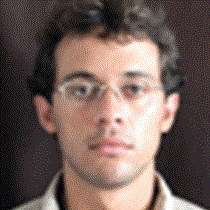WOW! What a fabulous day we have had today here in the enchanted islands of Galápagos! I gave an optional early wake-up call at 6:15 a.m. and soon most of our guests were bleary eyed, drinking coffee and nibbling muffins on the foredeck of the National Geographic Islander. It was a magnificent morning: the sun a fiery, orange ball slid behind grey clouds cast a golden glow on the softly rippled ocean as we navigated not far off shore. Wolf Volcano on northern Isabela Island loomed above us and while we searched for marine mammals and sea birds, I told our guests about the pink land iguanas that had recently been discovered there and just given a scientific name in 2009. I pointed out a dark-rumped petrel, a lovely sea bird that has been protected during the last 30 years and brought back from near extinction. And for an hour we all searched the horizon, I made small talk, and I secretly feared we would not find the dolphins and/or whales we were searching for.
But then – hurray! I spied dolphins leaping on the horizon and we moved slowly among them and soon were surrounded by a couple of hundred sleek, smooth and graceful bottle nose dolphins. We witnessed something I have never seen: a group of baby dolphins splashing and leaping and playing together, away from their mothers’ side. Dolphins approached the ship, some turned on their side and looked up at us, and they rode the bow wake. Just as I was about to ask first officer Ivan to set us back on course, I saw more splashing and flocks of sea birds about a half mile north, so we went to investigate. Pilot whales!!! We stopped the ship and yelling in delighted watched as at least a hundred black, bulbous headed, strong-tailed whales dove in tight family groups under and alongside us. They spouted and we repeatedly heard the wonderful sound of a whale “ffooof” as they exhaled and blew mist into the air. The sun shone on their gleaming black backs and this truly was a moment for all of us to remember. I have not seen a group of so many curious pilot whales in years and was as delighted – maybe even more so – than our guests!
We spend a half hour surrounded by whales and dolphins, snapping photos and marveling at the strength and beauty of these wild and fearless creatures. Then – only because I knew we could not afford to miss the rest of our morning activities – we reluctantly left them and went below for a hearty breakfast as the Captain headed onto our Equator crossing. At Punta Vicente Roca we had an amazing Zodiac cruise and got good looks at penguins, cormorants, really big marine iguanas, sea lions, fur seals and many other species of wildlife.
Back on board we wiggled into our wetsuits in a hurry and headed out in three Zodiacs to snorkel. The water was a bit murky and cool, but oh my goodness what incredible sightings we had! I think there are few places in the world where, besides a large variety of colorful tropical fish, one can snorkel with two species of reptiles (we saw marine iguanas swimming and feeding underwater and at least a dozen sea turtles), two species of endemic flightless marine birds (penguins were chasing tiny fish and flightless cormorants were diving and fishing and even pecking our fins with curiosity!) and even a marine mammal (sea lions darted among us). At noon we climbed ladders into the Zodiacs and motored back to the ship for lunch and a well-earned siesta.
In the afternoon naturalist Giancarlo gave an interesting presentation on the ocean setting of Galapagos; he explained the currents and the origin and variety of fish in the archipelago. Then we took the Zodiacs in for a dry landing on the rocky unspoiled shores of the westernmost island of Fernandina. The sky had clouded over and we were grateful for this as we hiked this afternoon on barren black lava. Marine iguanas were everywhere and they are large on these western islands! There were several loud and active male sea lions, and also a few juveniles, females and babies. One male seemed to be courting four lovely females at once and could not seem to decide which one to hang out with. Out on the point we found nesting flightless cormorants with eggs.
We slipped along on the still damp lava as we made our way, now at low tide, back to the Zodiacs. The sun set behind the rugged lava shores and mangrove forests of Fernandina – one of the world’s most pristine and untouched islands – we returned to the ship with smiles of contentment on all of our faces. It is a privilege to have seen these dolphins and whales, the cormorants, penguins and iguanas in their natural habitats, unafraid of us, unmolested and going about their lives as they have for millennium. The experiences we have shared today will no doubt remain burned in our memories forever and will hopefully inspire us to protect these creatures and all the other remarkable creatures on our marvelous planet.









